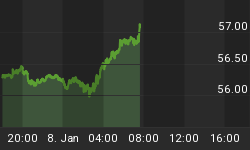Every comment made below needs to be taken in the context of possible Fed action. The Fed will most certainly do something in response to the recent weakness in the markets and deterioration in the economic data. The Fed is due to release their next formal statement on Tuesday, August 9.
We believe gold and silver are well positioned given current economic circumstances and any potential Fed action. Our gut and reading of the technicals and fundamentals tell us to favor precious metals over stocks in the short-to-intermediate term (maybe even longer). We recently added to our holdings in gold and silver and that turned out to be a good move, especially relative to stock market performance (see July 13 post).
The markets still have a mix of good news and bad news, but the bad news pile is now much taller than the good news pile. Tuesday's sharp drop in all risk assets, except gold and silver, did significant damage to the market's probabilistic outlook. Consequently, we must be willing to take increasingly larger incremental steps away from risk (raise a higher percentage of cash more rapidly).
Since market tops and bottom are formed based on the human emotions of greed and fear, they often occur via a process that takes time to play out. The bad news in the chart below is the bottoming process from the summer of 2010 looks like a mirror image of what may be a topping process in 2011. Notice how prices below took off in a bullish manner once the top end of the green box was exceeded. The tiny bit of "good news" is the current process has not yet broken below the orange box, but the odds tell us to prepare for it. A break below the orange box, could set off a relatively sharp drop in stock prices.

The chart of the S&P 500 below shows one example of a bull/bear line that was violated yesterday. The green arrows show that the last two times sellers brought the S&P 500 to the 200-day moving average buyers stepped up and prices rallied. Therefore, it was logical to be patient and see if the 200-day held again. We had sell orders queued up on Monday, but decided to hold off on selling for two reasons: (1) the Senate was due to approve the debt-ceiling compromise on Tuesday (which they did), and (2) buyers stepped in and propelled stocks back above the 200-day before the close Monday (see orange arrow). The red arrow below shows this time the 200-day did not hold, which factored into our decisions to execute sell orders before the close on Tuesday.

It should be noted during the shift from a bull market to a bear market in both 2000 and 2007, the S&P 500 zig-zagged above and below the 200-day moving average approximately ten times before we shifted into a full-blown bear market. That tells us that the market may pop above and below the 200-day several times over the next few weeks or months.
The 200-day example of above is one of many where bearish thresholds were crossed on August 2. The CCM 80-20 Correction Index is another example. On August 2, the 80-20 Index dropped to 609, which moved it into a much less favorable historical risk-reward zone (see orange boxes below). The higher the risk-reward ratio, the better the odds are for risk assets, like stocks. Notice the red boxes are the next stop if stocks cannot firm up in the next week or so.

The CCM Bull Market Sustainability Index (BMSI) paints a similar picture of deterioration in the market's risk-reward profile. The BMSI closed on August 2 at 2,392, which places it just above a very mixed zone in terms of historical risk-reward profiles for the stock market (see orange box).

How does all this help us? We did some selling on Friday and again on Tuesday (SPY and IYT). If weakness persists, we will continue to raise cash, possibly at a more rapid rate. We may also consider adding to our positions in gold (GLD) and silver (SLV).
















